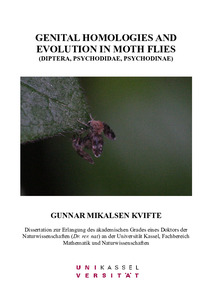| dcterms.abstract | Male genitalia are typically the most important morphological character system in zoological taxonomy and morphology-based phylogenetics. However, to establish their utility and significance in both these fields, a thorough and careful homologization is necessary. The present contribution attempts to view the genitalia of Psychodinae (Diptera: Psychodidae) in the light of recent advances in Diptera genital morphology in order to establish a working understanding of these important character systems and their evolutionary processes.
The arguments outlined in the thesis are the result of three years of detailed morphological studies into various lineages of Psychodinae and repeated attempts to synthesize all available information into a single narrative. Whenever possible, morphological studies have coincided with the solution of taxonomic problems or the exploration of faunistic patterns in Psychodidae; and thus the thesis comprises both review papers, taxonomic revisions and faunistic lists.
Chapter 2 is taken from the forthcoming Manual of Afrotropical Diptera, and gives a general review of Psychodidae in general and the Afrotropical fauna in particular. Besides morphology, the chapter covers species richness, natural history and economic and medical importance of the family. The chapter is reproduced with kind permission from Dr. Ashley H. Kirk-Spriggs, and is not to be redistributed in its current form. Pagination and layout may be subject to change.
Chapter 3 deals with the phylogeny of Psychodinae in order to define a phylogenetic framework in which to test hypotheses and identify taxonomically problematic areas. Using DNA sequence data taken from several previous molecular analyses as well as some newly generated sequences, a tentative phylogenetic classification for the family is proposed recognizing Psychodini, Brunettiini, Maruinini and Pericomaini sensu novo as the main four lineages. Of these, special attention is given to Psychodini, Maruinini and Pericomaini in the rest of the thesis.
Chapter 4 consists of two papers dealing with morphology and taxonomy of the Psychodini. The first part revises the genera of Psychodini of the Afrotropical region, with descriptions and redescriptions of three species of systematic importance. The second part describes a new genus and two new species from Costa Rica in collaboration with Gregory R. Curler and Stephen A. Marshall.
Chapter 5, co-written with Rüdiger Wagner, deals with the genus Neurosystasis as an exemplar taxon of the Maruinini. It is primarily a species description, but it also suggests that the posterior genital appendages of Maruinini can be fused surstyli and cerci; for which a new, homology-neutral term hypopod is proposed.
In Chapter 6, various morphological evolutionary trends within Pericomaini s.l. are explored in some detail. The first of four parts deals with the taxonomy of the traditionally problematic genus Telmatoscopus, resurrecting the genus Seoda and proposing a trend towards medial fusion of parameres within Pericomaini s.l.. The latter idea is elaborated in a revision of Psychomasina, which also introduces the surstylus/cercus fusion hypothesis. In the third and fourth papers, the psychodid faunas of Croatia and Mallorca are reviewed and two new Pericomaini s.str. are described.
Chapter 7 uses the new homologizations to trace the evolutionary history of asymmetric genitalia within Psychodinae. Even disregarding the diverse and often asymmetric taxa in Maruinini, a total of six different asymmetric conditions are found to have evolved within the subfamily, with various conditions of asymmetry evolving at least 14 times independently. Different hypotheses for evolutionary drivers behind this are proposed, including discussions of how they can be discriminated between. | eng |

